- Register
- Log in to Tune-In
- Wishlist (0)
-
Shopping cart
(0)
You have no items in your shopping cart.
Beatles News
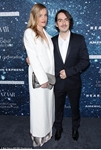
The son of late Beatles legend George Harrison has reportedly issued divorce proceedings against his wife of four years.
Entertainment news website TMZ claim singer-songwriter Dhani Harrison, 38, has cited irreconcilable differences as a motive for his separation from model turned psychologist Solveig 'Sola' Karadottir.
The musician, Harrison's only child with second wife Olivia Arias, is understood to have filed a petition to end their marriage in Los Angeles a week ago.
TMZ also claim the cost of spousal support and legal fees will be dictated by a prenuptial agreement entered by both parties prior to their marriage.
Dhani married Solveig, the daughter of deCODE Genetics co-founder Kári Stefánsson, at the Harrison's Friar Park estate in Henley-on-Thames in June 2012. Guests at the low-key ceremony included Hollywood star Tom Hanks, British actor Clive Owen and his father's two surviving bandmates, Ringo Starr and Sir Paul McCartney.
Solveig also wore an embroidered bridal gown designed by McCartney's fashion designer daughter, Stella. The statuesque former model walked down the aisle to Led Zeppelin track The Rain Song before exchanging vows with Dhani in details

An angry letter from John Lennon to Paul and his then-wife Linda McCartney following the breakup of The Beatles has sold at auction for just under $30,000.
Boston-based RR Auctions estimated the letter would fetch at least $20,000 when they announced the listing recently. And today they've revealed it sold for $29,843.
The two-page typed letter with hand-written annotations by Lennon shows the extent of his bitterness after the break-up of the Beatles.
The draft letter is believed to date from 1971 and was said to be a response to criticism that Lennon had received from Linda about his decision to not publicly announce his departure from the band.
It reads: “I was reading your letter and wondering what middle aged cranky Beatle fan wrote it.
“I resisted looking at the last page to find out. I kept thinking who is it, Queenie? Stuart’s mother? Clive Epstein’s wife? Alan Williams? What the hell – it’s Linda! Who do you think we/you are?
"Linda, if you don’t care what I say shut up! Let Paul write or whatever.”
Other items included in the sale were a Led Zeppelin debut album inscribed to the founding member of the James Gang whi details

“Brian was a flawed and imperfect hero, but he was a hero all the same.... So like all worthy heroes, why shouldn’t Brian Epstein have a life in comics?”
So said Vivek J. Tiwary in an essay at the back of “The Fifth Beatle: The Brian Epstein Story,” a graphic novel he wrote that has arrived in paperback. Despite the darkness at the heart of the story — Epstein had a number of problems, including the drug addictions that ended his life at 32 — the book is an ebullient, colorful biography, and the quote represents it quite well.
Epstein, for those not up on their Beatle history, was the first to recognize the band’s potential. He managed and guided them to international success, virtually created Beatlemania and in the process creating a new model for the music industry. Without him, the band might have ended in obscurity, playing in low-rent Hamburg nightclubs to the last.
Or not. But this isn’t a book about the Beatles — it is definitely Epstein’s story. Yes, the Beatles are somewhat overpowering, but they and all the other legendary figures in the swirl of the British Invasion remain supporting characters. But the spotlight remains firmly details
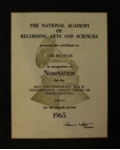
The Beatles' Grammy nomination for their 1965 song "Help!" will be auctioned by Nate D. Sanders Auctions on November 17. Interested bidders may participate in the auction online.
The Beatles received 27 Grammy nominations throughout their amazing career. The Grammy nomination being auctioned is for 'Best Contemporary (R&R) Performance - Group (Vocal or Instrumental)." The paper nomination, featuring an image of the iconic Grammy award screened in the background, is lacquered onto a wooden plaque.
The 1965 song "Help!" served as the title song for the Beatles' album and movie "Help!" John Lennon wrote the lyrics to the song to describe the stress the band was experiencing from its tremendous fame. The song was credited to John Lennon and Paul McCartney. "Help!" became the number one single in the United States and United Kingdom. Rolling Stone rated "Help!" as the 29th greatest single of all-time. Richard Lester directed the film "Help!" which netted over $12 million at the box office. Auction owner Nate Sanders stated, "This is rare item and a tribute to the greatest bands of all-time."
Bidding begins at $7,500.
Source: Broadway World

It’s been a bad 2016 for great musicians. Since January, we’ve lost David Bowie, Prince, Phife Dawg, Leonard Cohen, Leon Russell… please don’t make me keep going. It’s too depressing. Someone keep an eye on Chuck Berry.
Meanwhile, Bob Dylan, at 75 years young, is having himself quite the year. The legendary singer-songwriter released a warmly received new album; played Desert Trip alongside Paul McCartney (please don’t die) and Neil Young (same); and refused to acknowledge winning the Nobel Prize in Literature for weeks. Bob Dylan: he’s been best at giving no f*cks since the 1960s.
Speaking of: The Band guitarist Robbie Robertson wrote a memoir, Testimony, about, among other topics, his time on the road with Dylan in 1966. The 47-date world tour began in United States and ended nearly four months later with two shows at London’s Royal Albert Hall, which were later released as The Bootleg Series Vol. 4: Bob Dylan Live 1966, The “Royal Albert Hall” Concert. At tour’s end, Dylan was positively strung out on amphetamines (he later told Jann Wenner that “I was on drugs, a lot of things”) and could barely stand up, according to Rolling Ston details
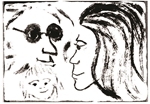
Rich Horowitz never met John Lennon, but the San Diego entrepreneur has spent more than a quarter-century bringing the former Beatle’s art to an international audience.
That’s art, as in Lennon’s lithographs, not music.
As one of the driving forces behind “The Art of John Lennon,” Horowitz was instrumental in the show’s 26-year run, which visited more than 100 galleries in about 30 cities across the U.S. and Canada.
Now, that run is coming to an end.
This weekend’s “The Art of John Lennon — Final Exhibition” will, at the behest of Lennon’s widow, Yoko Ono, be the last to be held anywhere. The free show, which runs Friday through Sunday at Del Mar’s Flower Hill Promenade, includes more than 120 serigraphs, signed lithographs and song lyrics by Lennon, including those for “In My Life,” “Nowhere Man” and “Revolution.”
“John’s artwork is very important, and his legacy is one of music, art and revolution,” Ono said via email. “These exhibits were my way of reminding people of John Lennon all the time.”
Horowitz has worked for the past quarter century details

Andy Warhol freaked out Sean Lennon by giving him a taxidermied pet cat for his eighth birthday.
When asked what Warhol was “going for” when he chose the gift, Lennon told Page Six, “I really don’t know.”
The singer revealed that when he unwrapped the gift, his mother, Yoko Ono, was “kind of disturbed despite her love of cats” and that the family’s (living) felines were “immediately enraged.”
In the story — revealed for the first time in an exhibit called “Letters to Andy Warhol” that just opened at the Cadillac House — Lennon writes, “After a brief time on a shelf in my bedroom, it was decided that Andy’s cat should reside permanently in the window of the office on the ground floor,” where it stayed until “neighbors complained and we had to take it down.”
He added, “Each day on my way to school I would walk by the office and wonder why it was that Andy gave me that cat.”
Asked if Warhol had run the idea by his parents before giving their son a dead cat, Lennon said, “My dad [John Lennon] wasn’t around at the time — it was just me and my mom &mdas details

A letter from John Lennon and Yoko Ono to Paul McCartney and wife Linda is up for sale at auction, with bidding expected to reach $20,000 (£16k).
The undated letter sees Lennon responding to prior correspondence from Linda which he says left him “wondering what middle aged cranky Beatle fan wrote it”. Lennon writes in his letter: “I hope you realise what shit you and the rest of my ‘kind and unselfish’ friends laid on Yoko and me, since we’ve been together”.
Elsewhere, Lennon goes on to say that he doesn’t “resent” his former Beatles bandmate but that he feels “sorry for him”. He also predicts that the McCartneys’ marriage would be over within two years.
See and read the letter in full below.
Robert Livingston from RR Auction says of the letter: “It was likely written shortly before Lennon and Ono’s departure for America. The draft captures the intense rivalry between the two men in the months, and even years, surrounding the breakup of the Beatles.”
Dear Linda and Paul, I was reading your letter and wondering what middle aged cranky Beatle fan wrote it. I resisted looking at the la details

The touching tribute will no doubt resonate with pop culture fans who've mourned their idols.
It has, of course, been one of the most prolific years for celebrity deaths. So it's perhaps not surprising that 2016's famous losses have been remembered in a touching tribute to British talent, inspired by The Beatles ' legendary Sgt. Pepper album, no less. Uploaded to Twitter on Saturday by a user called Christthebarker , the montage - which features everyone from Terry Wogan to Labour MP Jo Cox - has quickly gone viral and attracted international attention for its poignancy.
Using the famous LP sleeve as a blueprint, the design features more than forty famous face and has been shared in excess of 1,000 times. Populating the front row are David Bowie, who died of cancer in January, Muhammed Ali, Gene Wilder, Prince and Victoria Wood, plus Caroline Aherne and Motorhead's Lemmy. Although he actually passed away in 2015. Before them sees the word 'BREXIT' spelled out in red flowers, while Donald Trump's iconic Make America Great Again hat features alongside a Leicester City shirt, which offers a nod to their triumphant title win.
Others who feature in the collage include Carla Lane, Alan Rickman, Denise Robertso details
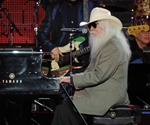
Leon Russell, who sang, wrote and produced some of rock 'n' roll's top records, has died. He was 74. An email from Leon Russell Records to The Associated Press says Russell died Sunday in Nashville.
The email cites Russell's wife as the source of the information.
Russell had heart bypass surgery in July and was recovering from that at the time of his death. He had been planning on resuming touring in January, the email said. Russell's official website also says the musician died Sunday. Besides his music, Russell was known for his striking appearance: wispy white hair halfway down his back and that covered much of his face.
Russell played keyboard for the Los Angeles studio team known as the Wrecking Crew, helping producer Phil Spector develop his game-changing wall of sound approach in the 1960s. He wrote Joe Cocker's Delta Lady and in 1969 put together Cocker's Mad Dogs and Englishmen tour, which spawned a documentary film and a hit double album.
As a musician, primarily a pianist, he played on The Beach Boys' California Girls and Jan and Dean's Surf City. He also played guitar and bass. Russell produced and played on recording sessions for Bob Dylan, Frank Sinatra, Ike and Tina Turner, the Rol details

Being original Beatles drummer Pete Best has never been easy, but it was especially tough in 1964 when Beatlemania swept the world and he had to watch from the sidelines. In March of 1964, the Beatles had the top four songs on the Hot 100: "She Loves You," "I Want to Hold Your Hand," "Twist and Shout" and "Please Please Me." They were four of the most famous people on the planet, but when Pete Best walked onto the set of I've Got a Secret that month nobody knew who he was.
He introduced himself to the panel as Pete Best from West Derby in Lancashire, England before whispering his secret to host Gary Moore. "I left my job two years ago," he said. "I was one of the Beatles." The panel was merely told his secret involved something he did. Bess Myerson (Miss of America of 1945 and a staple of 1950s television) immediately noticed his haircut. "Could you be a new kind of bug that we've imported from England?" she asked. "Do you have anything to do with your predecessors, the Beatles?"
Bill Cullen was up next, and like many Americans at the time, he was fixated the Beatles' haircuts, thinking he might be their barber. He did get Best to say he still "vaguely" had something to do with the Beatles. Betsy Palmer (who wen details

Fashion designer Stella McCartney unveiled her first menswear collection on Thursday at London's famous Abbey Road recording studio, where she promised men a more free and fun wardrobe.
She chose to present the collection at the recording studio made famous by her father, Paul McCartney, and his three fellow Beatles when they named one of their albums after Abbey Road. The fashion show referenced the 1969 album cover, which shows the band walking across Abbey Road, by parading models over the same white stripes to photographers' flashes.
McCartney said the venue was special both for its musical and family ties.
"It really means a lot to our family this studio... seeing and hearing what's been created here, the best music in the world. It's such an iconic place. So many people have recorded here," she said.
Pink Floyd, Radiohead, the Manic Street Preachers and Blur are just some of the other bands to have recorded at Abbey Road in recent years.
McCartney, who trained at the Central Saint Martins College of Art and Design, has built a reputation as a designer but has only just decided to enter the world of menswear. The collection shown at Abbey Road ranged from playful casual wear, such as details
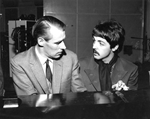
The identity of the true "fifth Beatle" has been hotly debated for half a century, but the strongest case can be made for Sir George Martin. The band's trusted and loyal producer, Martin served as expert and conspirator, taskmaster and mad scientist, friend and father figure throughout the band's studio life. He shaped their songs in ways that are seldom appreciated but impossible to forget.
Unlike most producers of his era, his creative daring fostered an environment where it was acceptable to explore and expand the realm of the possible. He played with the Beatles, in every sense of the word — by picking up an instrument, or merely indulging their curiosity and translating their abstract musical fantasies into reality. "He was always there for us to interpret our strangeness," recalled George Harrison. It's difficult, and frightening, to imagine the Beatles' artistic trajectory had they been paired with anyone else. His role as a confidant, advocate and realizer cannot be overstated.
These are 10 of our favorite moments in the Beatles' catalog that we owe to George Martin.
"Please Please Me" (1963)
When John Lennon and Paul McCartney first played "Please Please Me" for George Martin durin details

“I don’t think of the Fifth Beatle as an activist book. I certainly don’t have a political agenda but I do hope it’s an inspiring book. I hope that when people finish reading it they close the book inspired to chase their own dreams in the world however they see fit.” – Vivek Tiwary
The Fifth Beatle is the graphic novel debut of Tony Award Winning Broadway Producer Vivek J. Tiwary. This New York Times #1 Best Selling exploration of pop culture & personal identity brilliantly chronicles the story of “Gay, Jewish, Kid from Liverpool” Brian Epstein, The Beatles visionary manager. Myself being a “Bleek (Black Geek) from The Bronx” could relate to Brian’s outsider status and my discussion with Vivek (pronounced like cake) a self described, “Weirdo Indian Kid from the Lower East Side” made me realize what we shared in common.
Vivek and I are both first generation Americans. Vivek’s folks are Guyanese of Indian extraction, my parents were from Barbados. We bonded sharing West Indian tidbits and his parents traditional expectations on career choice really hit home for me. While at Wharton Business School, on track to j details

Before George Martin's death on March 8th, the legendary producer and "fifth Beatle" aligned with PBS for an eight-part series titled Soundbreaking: Stories From the Cutting Edge of Recorded Music. For the series, which was five years in the making, Martin and his son Giles recruited over 150 artists to share behind-the-scenes stories about the art of recording.
The first two Soundbreaking episodes are scheduled to premiere March 14th at the SXSW Film festival with a PBS premiere set for November. Rolling Stone has the exclusive first look at the Soundbreaking trailer, featuring Ringo Starr, Elton John, St. Vincent, Bonnie Raitt and Don Was discussing their craft.
"My first meeting with the Rolling Stones, I ended up with Mick Jagger sitting here and Keith [Richards] sitting here, and they were both talking at the same time," says Was, who first worked with the Stones on 1994's Voodoo Lounge. "Keith said, 'You sure you want to be the meat in this sandwich?'"
Directed and produced by Jeff Dupre and Maro Chermayeff, the series features 150 exclusive and original interviews with both artists and producers. Paul McCartney, Tom Petty, Roger Waters, Roger Daltrey, Dave Grohl, Questlove, Bon Iver, Willie Nelson details
